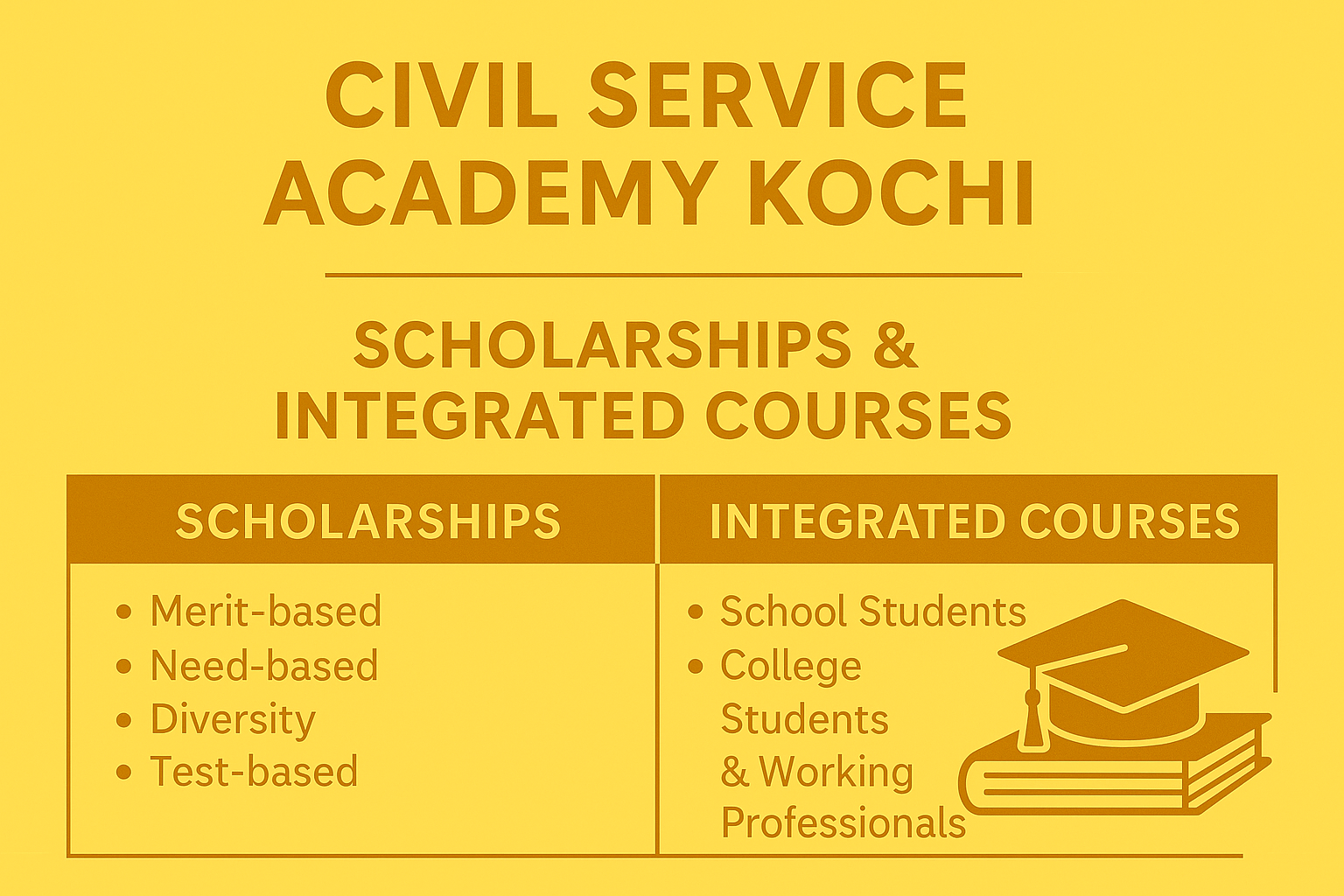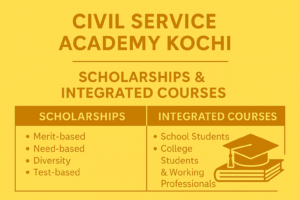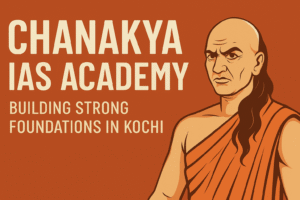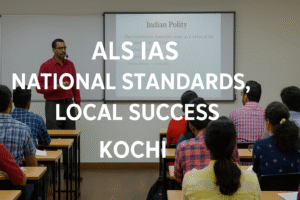Why Kochi is a strong base for UPSC prep
Academic ecosystem: Multiple IAS/IPS coaching providers, public libraries, and university crowd for peer learning.
Connectivity & study convenience: Metro/bus access across Kadavanthra, Vyttila, Edappally, MG Road; hostels and student PGs nearby.
Balanced cost of living: Generally lower than Tier-1 metros while offering comparable coaching quality.
Growing test-prep market: Many academies now run scholarship tests and integrated programs that combine school/college with UPSC prep.
Scholarship Options in Kochi (What to expect)
Most academies run multiple scholarship lanes. Shortlist those you qualify for and stack only where rules allow.
| Scholarship Type | Typical Basis | Benefit Range* | Evidence/Docs | Renewal Rules |
|---|---|---|---|---|
| Merit-based (Board/University Topper) | Class X/XII/UG marks | 10–100% fee waiver | Mark sheets, rank letter | Maintain set attendance & test performance |
| Scholarship Test (Aptitude + GS) | Institute’s exam | Slabbed: higher score → higher waiver | Test scorecard; ID proof | May require minimum scores in internal tests |
| Need-based (EWS/Low income) | Family income threshold | Partial waiver + installment plan | Income certificate, affidavit | Annual income revalidation |
| Girl Student Scholarship | Gender diversity | Fixed % waiver | Govt ID + education docs | Usually once at admission |
| SC/ST/OBC (NCL)/EWS/ PwD | Category status | Preferential waivers | Valid certificates | Per policy; may combine with merit |
| Children of Defence/Ex-Servicemen | Service background | Fixed/Slabbed waiver | Service/Discharge book | Once, sometimes renewable |
| Sports/Cultural Achievers | District/State/National rep. | Slabbed waiver | Certificates from assoc./federation | Maintain academy attendance |
| Early-bird/Launch Offers | Date-bound enrolment | 5–25% typical | Admission receipt | Not renewable |
| Alumni/Referral | Past student link | Flat waiver or voucher | Alumni ID/contact | One-time |
| Differently-abled support | Accessibility + fee aid | Case-by-case | Medical/PwD docs | Per policy |
*Ranges vary by institute and course (Foundation, Prelims-cum-Mains, Test Series). Always demand a written scholarship letter with terms.
How to apply for scholarships (step-by-step)
Shortlist academies offering your course (Foundation / Prelims-cum-Mains / Optional).
Collect docs: ID, photos, mark sheets, income/category certificates, achievements.
Register for scholarship test (if applicable); note syllabus & pattern (GS basics, reasoning/CSAT, reading comprehension, basic current affairs).
Attend counseling to understand fee heads (tuition, tests, materials, mentoring) and renewal conditions.
Get everything in writing: total fee, scholarship %, net payable, installment dates, refund/deferral rules.
Confirm seat within deadline; keep fee receipts & sanction letter.
Integrated IAS Courses in Kochi (Formats & Fit)
1) School-Integrated Foundation (Classes 8–10)
Focus: NCERT fundamentals (Geography, Polity, History, Economy), reading habit, answer writing basics.
Format: Weekly classes + monthly tests; vacation bootcamps; parent review meets.
Outcome: Concept base, curiosity, and discipline—no heavy load.
2) Plus One/Plus Two + IAS Foundation (Classes 11–12)
Focus: Board synergy + UPSC basics; CSAT reasoning; current affairs method; note-making.
Format: 2–4 sessions/week; structured assignments; board-friendly pacing.
Outcome: Smooth jump to degree-level UPSC track; early mastery of NCERTs.
3) Degree-Integrated (BA/BSc/BCom/BTech + UPSC)
Focus: Prelims-cum-Mains roadmap across 2–3 years; optional subject exposure; internships/volunteering for profile.
Format: Evening/Weekend classes, semester-break intensives, test series from year-2.
Outcome: Graduate with a strong Prelims/Mains base; attempt during or right after graduation.
4) Working-Professional Integrated (Evening/Weekend)
Focus: Time-boxed study plans; CSAT drills; revision sprints; productivity systems.
Format: Fri-evening + Sat/Sun; hybrid classes; heavy use of recorded back-ups.
Outcome: Consistency without quitting job; attempt in 12–18 months.
5) Hybrid/Online-Integrated
Focus: Flexible attendance, LMS tracking, doubt rooms, digital tests.
Format: Live + recorded, online mentorship, periodic offline bootcamps.
Outcome: Location-agnostic with measurable progress.
Core modules every integrated course should include
GS I–IV mapped to NCERT → standard texts → advanced notes
CSAT (quant, logic, DI, comprehension) from day-1
Current Affairs (newspaper routine + monthly compendium + PYQ linkage)
Answer Writing & Essay with rubric-based feedback
Test Series (topic/sectional/full-length; OMR & descriptive)
Mentorship (weekly targets, audit of notes, micro-plans)
Optional Subject Orientation (fit check, resource map)
Interview Readiness (profile building, mock panels closer to attempt)
Sample 12-Month Roadmap (Prelims-first strategy)
Months 1–3: NCERT sweep (VI–XII) + CSAT basics + note-making system
Months 4–6: Standard books (Laxmikanth, Spectrum, GC Leong/atlas, Shankar Env., economy basics) + weekly tests
Months 7–9: Full Prelims drill (PYQs, revision cycles, mixed tests) + Mains answer writing starter
Months 10–12: Prelims sprints, then pivot to Mains GS & Essay immediately after Prelims
Fees, EMI & Refunds: What to check
Written breakup of fee heads: tuition, materials, tests, mentorship, portal, admin.
EMI options: card-based EMI, NBFC EMI, in-house installments—get the calendar & penalties in writing.
Scholarship net payable: confirm final amount after waiver + taxes.
Refund/deferral policy: timelines, documentation, and exceptions (medical, transfers).
Attendance expectations tied to scholarship renewal.
Choosing the right academy (10-point checklist)
Faculty depth (GS & Optionals; real classroom hours).
Test-series quality (PYQ mapping, analytics, feedback).
Mentorship (named mentor, review frequency).
Syllabus plan (dated timetable, milestones).
Scholarship clarity (written terms, renewal).
Batch size and doubt-solving channels.
Result transparency (verifiable names/years).
Learning systems (LMS, recordings, study rooms).
Location & logistics (metro/bus access, hostel ties).
Trial class before paying.
Admission Calendar (suggested)
Jan–Mar: Scholarship tests & early-bird offers
Apr–Jun: School/College integrated intakes; Prelims-first batches
Jul–Sep: Degree-integrated & weekend cohorts
Oct–Dec: Revision capsules; interview programs; next-year foundations
Documents Checklist
Photo ID, passport photos
Academic marksheets (X, XII, UG/PG)
Category/Income/PwD/Defence certificates (if applicable)
Scholarship test admit card/scorecard
Address proof; undertaking/parent consent (school-integrated)
FAQs
Q1. What is an “integrated IAS course” in Kochi?
It combines school/college schedules (or a working professional’s week) with a structured UPSC program—GS, CSAT, current affairs, tests, and mentorship under one timetable.
Q2. Who should pick a school-integrated foundation?
Students in Classes 8–12 who want strong NCERT fundamentals and habits without overloading board preparation.
Q3. How do scholarship tests work?
Institutes set a GS/aptitude paper; higher scores earn higher fee waivers. Some also add interviews or academic record checks.
Q4. Can I stack multiple scholarships?
Often no; most academies allow only one active waiver. Confirm in writing.
Q5. Are scholarships renewed every year?
Many are one-time. If renewable, they tie to performance, attendance, and internal test scores.
Q6. What’s the ideal path for a degree student?
A 2–3 year integrated track: NCERT + standard books in year-1, test series + answer writing in year-2, attempt planning by year-3.
Q7. Weekend courses—are they enough?
Yes, if paired with daily self-study (2–3 hrs on weekdays) and disciplined use of recordings and test feedback.
Q8. Do Kochi academies provide EMI?
Many do. Get installment calendar, late-fee rules, and net payable post-scholarship in writing.
Q9. How soon should I start answer writing?
From month-3 (short notes and 10-marker practice), scaling up to full papers as you near Mains.
Q10. What optional should I choose?
Pick based on interest, scoring pattern, guidance availability, and resources—not just trend lists. Attend orientation before locking in.










